Top News

April 16, 2012 Kyoko Agarie Correspondent of the Ryukyu Shimpo
Attracted by the nature and people of Izena, three young women from Shiga Prefecture, Chigusa Akata, Kaho Isobe, and Miki Kojima, who had come to the island on a school trip when they were in their second year of high school, visited Izena again after having graduated. They enjoyed spending time with local residents as they reminisced about the memories of their school trip,
“The sea was beautiful and people were very nice to us.” They enjoyed making sata-andagi, also known as Okinawan doughnuts, and the interaction with the island’s residents on a school trip, and decided to visit it again after graduating.
The three young women met Tomiyoshi and Hiroko Nakada, who have run an inn that they had stayed. During their six-day trip, Nakada took them around the island, and they spent a time with local people. All three of them said that will definitely come back again.
When leaving Izena waving happily, they held paper tapes on the ship with the Nakada couple holding the other end on the pier, the same as they had done on their school trip.
(English translation by T&CT, Lima Tokumori and Mark Ealey)
Go to Japanese
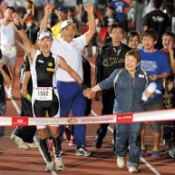
April 16, 2012 Ryukyu Shimpo
On April 15, the 28th All Japan Triath about us lon Miyakojima (co-hosted by Miyakojima City and the Ryukyu Shimpo) was held with 1470 triathlon athletes started off at 7:00am that morning. The competitors pit themselves against each in a very strenuous race consisting of a three-kilometer swim, a 155-kilometer bicycle ride and a 42.195-kilometer full marathon. One thousand two hundred thirty six people completed the race. Anton Balokhin from the Ukraine won his first victory in Miyakojima with a time of 8 hours 6 minutes 54 seconds. Hiroyuki Nishiuchi from Hyogo came second, followed by Kodo Hiramatsu from Kanagawa. Shinya Suganuma of Team Goya was the highest-ranking athlete from Okinawa, coming in sixth with a time of 8 hours 14 minutes 46 seconds.
Goertz Beate from Germany won her first victory in the women’s race with a time of 8 hours 34 minutes and 31 seconds. Walter Verena, also of Germany, was second, followed by Hiromi Matsumaru from Ibaraki. Some 83.7% of all participants finished the race.
(English translation by T&CT, Mark Ealey)
Go to Japanese

Go To Video
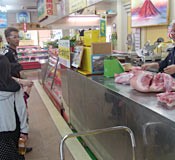
April 10, 2012 Correspondent Yoshikatsu Miyagi of the Ryukyu Shimpo
From April to October, 2012, the Nago Tourism Association and the Japan Travel Bureau (JTB) Okinawa will run a town tour guide project in Nago in the north of Okinawa. On April 3, the first four tourists on this project, parents and children from the main islands of Japan visited Nago. They saw the Hinpun Gajumaru, a 300 year-old, huge banyan tree designated as a national nature treasure and the symbol of Nago, and learned about its history and culture, as well as enjoying some local Nago cuisine. The association and JTB provide two options – one on bicycle and one on foot walking around the town with a tour guide. The association provides information for the tourists, and the tour guide operation is entrusted to the NPO group HICO.
Tsukasa Agarie, one of the local guide members who have completed the training course for the town tour guide sponsored by the Nago Machinaka Museum Committee last year, looked after the first visitors. He told them stories of culture and scenery rooted in local life, including the story of the residents of Nago and pitou or dolphin, the rikuyu or a six moral instructions by Tei Junsoku, a Confucian scholar and political leader during the Ryukyu dynasty who was active from the late 17th century into the 18th century, and Gajumaru-ganta, the mascot character of Nago.
Masaaki Ueda, who visited Nago from Shiga on his fifth trip to Okinawa, said, “I want to learn more about Okinawa, so I booked immediately when I heard about this project. The municipal market tour and the story of the gajumaru tree were a lot of fun and very meaningful for our family.” They tasted Shinzan soba in a well-established restaurant at Nago for lunch on the recommendation of the guide.
Shigefumi Higa the bureau chief of the association said, “The cultural properties are regional treasures. We will learn from the town tour guide project to produce further tour plans to attract tourists from outside the prefecture in cooperation with the regional tourism coordinator. We would like to provide appealing information about what Nago offers.”
(English translation by T&CT, Mark Ealey)
Go to Japanese
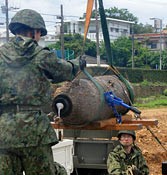
April 16, 2012 Ryukyu Shimpo
Just before 11:00am on April 15 in the grounds of Shuri High School in the Mawashi area of Shuri, Naha, Ground Self-Defense Force personnel disposed of an unexploded WWII U.S. 250 kilogram shell (120 centimeters long and 36 centimeters in diameter). The shell had been found when the reconstruction of a school building was carried out in February. About 2350 people were evacuated from about 845 households and 95 business premises within 288 meters of the site where the disposal work was carried out. Traffic control was implemented for 19 locations, including Route 29. About 20 unexploded shells have been found at Shuri High School during drilling works for the reconstruction of a school building and as the result of magnetic surveying that has been carried out since August 2011. Twelve local residents were evacuated to the gymnasium of Josei Elementary School in Naha.
The disposal work was completed about an hour ahead of schedule and no damage occurred.
The areas evacuated included the Hotel Nikko Naha Grand Castle and part of Shurijo Castle Park. The hotel did not accept guests in the evening of April 14 and stayed closed until the disposal work was completed. The park let visitors temporarily park their cars at the site of the former Okinawa Prefectural Museum. Naha Bus services were diverted from 9:00am to 11:00am.
(English translation by T&CT, Mark Ealey)
Go to Japanese
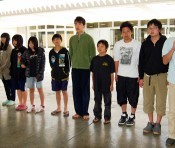
April 8, 2012 by Hideaki Yoneda, correspondent of Ryukyu Shimpo
Ryuji and Akiko Sakata, a couple who moved to Tokashiki from Kudaka in 2007, ran the Warabiya juku as the first domestic study program in Tokashiki, finished accepting students in 2011. They then moved to Ogimi in northern Okinawa this April and will work to support children in areas affected by the Great East Japan Earthquake such as Fukushima.
The Sakatas set up in a house in Tokashiki and took in six to seven students from urban areas, aged from fifth grade of elementary school to third grade of junior high school, every year from 2008 to 2011. Living together with the Sakatas, the children grew rice and vegetables, helped look after a goat, and went to Tokashiki Elementary and Junior High School.
In the context of the number of pupils at the school decreasing year by year, the Warabiya pupils helped to add life to the local community, so many people regret its closing. On March 25, the Sakatas and the children participated in a local event known as Hamauri, and said, “We really appreciate the support we got from the people of Tokashiki.”
(English translation by T&CT, Lima Tokumori and Mark Ealey)
Go to Japanese
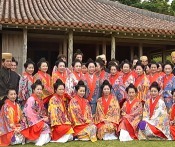
April 12, 2012 Ryukyu Shimpo
On April 9, at the Shikinaen garden in Naha, the Toshiko Chinen Ryubu-dojo and Ryusogakuin Institute held a graduation ceremony for students who had completed the course in ryuso and karajiyui or Okinawan traditional dress and hair-arrangement. At the course, the students can master techniques of the ryuso fitting and karajiyui fixing to make use of them in looking for jobs. The central government supports the course with funding as a vocational training project. Twenty-nine students received certificates of completion, which are level three and higher for half a year’s study, from Toshiko Chinen the president of the institute.
According to the Ryusogakuin, this is the first time that the government has supported vocational training for traditional cultural assets, with its main support for job training being for personal computer training courses. The students taking the course are unemployed workers who do not receive unemployment benefits. This project is supported by the government and certified by the Central Vocational Ability Development Association and involves free tuition. About ten students who completed the course have found jobs in beauty parlors.
Kanako Kamiya said, “I have learned ryubu (Okinawan traditional dance) and I attended this job training course because I want to master ryubu in future. I would like tourists who have never experienced Okinawa traditional dress to do so.” Kamiya said that she is keen to work in the Okinawan tourism industry and Junji Kinjo, one of three male students, said, “I used to run a bike shop, but attended the course because I wanted to try something new as I entered middle-age. The more I studied, the more I realized how much was involved.” Kamiya says that he wants to run his own shop in future.
Yuri Ikeda, the director of the institute commented, “In Kyoto, tourists enjoy dressing up as a maiko or dancing girl and walking around and taking photographs in the street. Similarly, we need people for ryuso and karajiyui to promote Okinawan tourism.”
(English translation by T&CT, Mark Ealey)
Go to Japanese
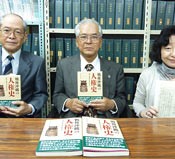
April 9, 2012 Ryukyu Shimpo
To mark the 50th anniversary of its establishment, the Okinawa Human Rights Association, which was established when Okinawa was under U.S. military administration and has since been involved in the protection of human rights for the people of Okinawa, has published the History book of human rights in Okinawa after World War II through the Kobunken publishing company. The book will be sold at bookstores in Okinawa from April 13 and covers citizens’ human rights movements in set periods. Editorial staff recommended the book, saying, “It summarizes the history of human rights in Okinawa. We would like people ranging from students to senior citizens to use it as a handbook for human rights.” The price is 2415 yen including tax.
The book describes Okinawa after World War II as a place where there was no constitution because neither the Japanese Constitution nor the American Constitution were applied at that time. The Association, which was formed as a safe haven for people whose human rights were abused, handled many cases. They included cases related to matters such as U.S. military forces’ thought investigations, travel bans and disenfranchisement in Okinawa. The Association received notification of 130 cases in the first year of its establishment and the book describes how the Association scrambled to appeal to the relevant authorities.
The book also extensively covers cases related to issues of deployment of the Self-Defense Forces in Okinawa, women’s rights regarding inheritance of a spirit tablet and the issue of stateless children, which came to symbolize the 1980s. The book includes not only historical facts but also excellent columns written by editorial staff. These included the incident in which the U.S. military administration dismissed then Naha mayor Kamejiro Senaga, and the Takae lawsuit, in which a decision was made in the lower court this March. Chief editor of the book, Toshiaki Nakahara, who is the president of the Okinawa Christian University, said, “The book covers the history of human rights in Okinawa, and really I would like many people in Okinawa to read it.”
(English translation by T&CT, Mark Ealey)
Go to Japanese
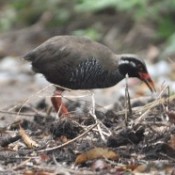
April 6, 2012 Ryukyu Shimpo
In the afternoon of April 5, photographs were taken of an Okinawa rail, a national natural treasure, looking for food on an old road in the Yambaru forest in the northern part of Okinawa. Wild birds in the Yambaru forest are now entering their mating season. The photographs were taken on a side road just 50 meters off the old road facing Prefectural Highway 70 at Sosu in Kunigami, which is an area designated for accident prevention. The bird was pecking away at a worm in dirt piled up on the road.
By April 4 this year, there had already been ten traffic accidents, three times more than by the same date last year, which posted a record high of 37. Makoto Fukuda, a staff member of the Yambaru Wildlife Conservation Center of Ministry of the Environment said, “Okinawa rails look for food in the dirt, so it is important to clean up the ditches to prevent the rails from being involved in accidents.”
(English translation by T&CT, Shinako Oyakawa and Mark Ealey)
Go to Japanese
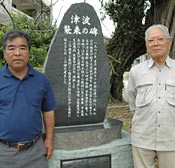
April 11, 2012
In order to commemorate the tsunami in Chile in 1960, Oura Ward in Nago set up a monument at Asagi-Mae Park. The Great East Japan Earthquake made 82 year-old Jun Higa think that it is important to pass down the experience of the Chile tsunami to future generations. A group of people in the ward also started making stairs to an escape route leading to a hill, so that it will be easier for elderly people to escape in the case of a tsunami.
When the Chile Tsunami occurred in Oura, women who had gone to the sea early in the morning to collect water to use for making tofu noticed the tell-tale early signs of the tsunami when they sensed that the waves were moving strangely. Because there was a mountain directly behind the district, there was no human suffering. The bell used to warn people of the impending tsunami still exists in Asagi-Mae Park.
However, a five-meter tsunami destroyed Oura Bridge and sea walls. All of the houses were flooded, and livestock such as pigs and goats were washed away. Jun Higa said, “There were no tsunami warnings in those days, and we didn’t expect it.”
The monument was set up using donations from Tsutomu Higa, who is from the district and currently lives in Okinawa City. An unveiling ceremony was held on March 25.
Ward mayor Yasuyuki Higa, who was inaugurated in April, said, “I would like to raise the community’s awareness of disaster prevention.”
(English translation by T&CT, Megumi Chibana and Mark Ealey)
Go to Japanese
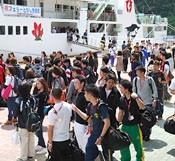
April 13, 2012 Hideaki Yoneda, correspondent of the Ryukyu Shimpo
With the beginning of a new academic year, on April 5, high schools, colleges, technical schools and companies in Okinawa commenced induction courses at the National Okinawa Youth Friendship Center in Tokashiki.
A total of about 800 participants, including 131 students of Okinawa University are scheduled to be in Tokashiki until May 10. During the courses, the village’s normal population of around 700 will be swelled by the influx of students.
The students are scheduled to participate in two and three-day courses in which they will get to know their colleagues and teachers through outdoor and nature experiences, including marine sports.
Newly-enrolled students from high schools such as Konan, Haebaru and Okinawa Shogaku, Naha International and Tomigusuku Minami and the University of the Ryukyus and Okinawa Christian University, and new employees from Tomishiro Central Hospital will continue to visit the island through until the end of May. The ferry Tokashiki, a newly built ship owned and operated by the village, will carry a total of about 4000 participants from Naha Tomari Port.
On April 22, the island will open its beaches ahead of the tourist season.
(English translation by T&CT, Mark Ealey)
Go to Japanese
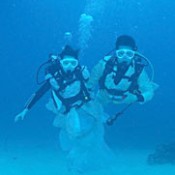
April 10, 2012
On April 5, at Seragaki in Onna, a couple from Macao held an underwater marriage ceremony in Okinawa, a place they love dearly. The bride and groom, Wong Si Wai and Leong Lap Chong both said, “It was just fantastic!”
Wearing a wedding dress and tuxedo over their wet suits, the couple exchanged rings, kissed, and had a video recorded of them swimming in the beautiful sea.
Because both the bride and groom love marine sports and have been diving in the sea off many different countries, they decided to have their marriage ceremony in the beautiful ocean. After gathering information about underwater marriage ceremony options all over the world through the Internet, they thought that the underwater wedding plan in Okinawa looked the best.
Wong studied Japanese for a year at Doshisha University in Kyoto, but she had never seen the ocean around Okinawa. “It was a little cold but very nice in the water. This summer we will invite between 200 and 300 people to our wedding reception in Macao. I would like to show them our underwater marriage ceremony,” she said with a smile.
Taku Ohara of the Benthos Divers in Onna, a diving company that has helped with underwater wedding ceremonies since 2000, said, “They are our first customers from abroad. I hope that the beauty of the ocean around Okinawa will become better all over the world.”
(English translation by T&CT, Lima Tokumori and Mark Ealey)
Go to Japanese












 Webcam(Kokusai Street)
Webcam(Kokusai Street)


